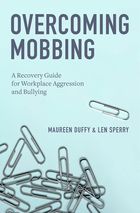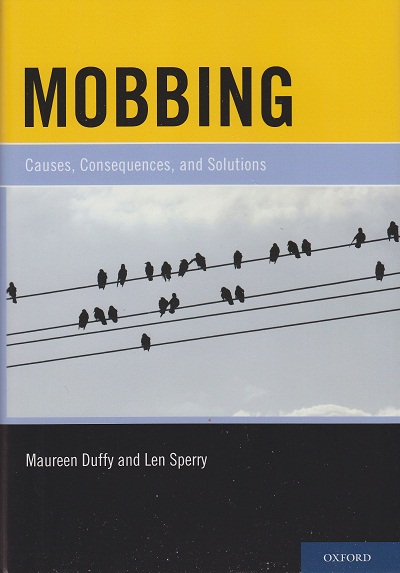Click on the covers to view descriptions at Oxford University Press.
CHOOSE BETWEEN
TWO NEW INTRODUCTIONS TO MOBBING
BY TOP-NOTCH AMERICAN PSYCHOLOGISTS
MAUREEN DUFFY AND LEN SPERRY,
BOTH BOOKS FROM OXFORD UNIVERSITY PRESS.
The latest, to be released at the end of 2013, is a practical guide: Overcoming Mobbing.
The foundational volume, Mobbing, came out in 2012.
_______________________________________________
Foreword
to Maureen Duffy and Len Sperry, Mobbing,
by Kenneth Westhues
This book would be a pleasure to introduce if it were only a thorough, up-to-date, easy-to-read summary of research on a serious problem of human relations at work. This book is more than that.
Mobbing is a new concept, a new word that has crept into the vocabularies of employees and employers over the past thirty years in all countries of the Western World. The word already existed, of course, but in the sense of violent eruption of political unrest. In its new meaning, the word refers to an outpouring of intense but usually nonviolent collective hostility toward a workmate. This linguistic innovation began in Scandinavia, where Swedish psychologist Heinz Leymann coined the term workplace mobbing, drawing on earlier research in ethology by Nobel Laureate Konrad Lorenz. News of Leymann’s studies spread across northern Europe, to Italy and Spain, and finally, over the past dozen years, to the Americas and Australia.
What you hold in your hands is the first book on workplace mobbing from a major publisher in the United States. In 1999, a small company in Iowa released the deservedly popular paperback on this subject by Noa Zanolli Davenport and her colleagues. Mellen Press then published a long series of scholarly research reports. Meanwhile, articles about mobbing have been coming out in dozens of academic journals, as well as leading newspapers and magazines. Now at last, one of the most respected publishers in the English-speaking world is releasing a comprehensive book on mobbing. It is careful and comprehensive enough to win academic kudos, yet fluent and readable enough to deserve the broadest public readership. Publication of this book is something to celebrate, a landmark event in the development of a body of knowledge that substantially deepens our understanding of what happens to people in their jobs.
The word mobbing, even if sometimes hazily defined, has caught on throughout the world simply because it fits with what ordinary people can see happening in their workplaces. It resonates with their experience. They have themselves witnessed interruptions of business as usual, breaks from the office routine, occasions wherein managers, peers, or some combination thereof gang up on a co-worker and make that person’s life a living hell, toward eliminating the target one way or another from the workplace. Leymann’s gift to all of us was to put a name on this extraordinary process, exhilarating for the perpetrators, terrifying for the target, momentous in the lives of all concerned. Having the word mobbing in our lexicon lets us recognize and understand bizarre events in our working lives that would otherwise be incomprehensible. It is a “necessary word,” as British litterateur John Sutherland has recently opined.
I would highlight six strengths of the present book.
First, the understanding of mobbing with which the book begins is not facile or mechanical, but rich in depth and insight, and informed by a wide reading of history and current affairs. These authors are not narrow, superficial specialists. They are mature, broadly educated scholars able to situate their specific subject matter in the larger contexts of social science and humane learning. They appropriately include lucid discussion of similarities and differences between workplace mobbing and other impassioned outbursts of collective hostility, from witch hunts in seventeenth-century New England to hysteria over Satanic ritual abuse of children in late twentieth-century California.
Second, the exposition here of what mobbing means is enhanced immeasurably by analysis of real-life examples, case studies of the process in varied kinds of workplace. This leaves the reader with an understanding of this phenomenon more complex than can be gained from any measuring instrument or checklist of indicators.
Third, these authors steer shy of the self-help genre that already encompasses too high a proportion of trade books in social science. They write less as experts dispensing recipes for how to cure what ails you, than as teachers providing resources for readers’ respective journeys in self-education. There is no quick fix for mobbing as a personal tragedy or organizational pathology. Duffy and Sperry wisely disclaim “one size fits all” remedies. They do not give readers ideas to swallow, but insights to reflect on and apply creatively to the widely discrepant situations in which readers find themselves.
Fourth, this book appropriately treats mobbing in schools, whether of administrators, teachers, or students, not as a separate field of study but as categorically similar to mobbing in the public service, hospitals, condo corporations, or wherever else. Schools are one kind of workplace. The general principles for understanding the nature, techniques, stages, causes and consequences of mobbing in schools are the same as for workplaces of whatever other kind.
Fifth, while avoiding overgeneralization and sweeping statements, Duffy and Sperry do not mince words about the basic findings researchers of mobbing have come up with. A good example is what they say about departments of human resources. The blunt truth is that notwithstanding the good intentions of many functionaries in these departments, they are structurally branches of administration, subject to the organization’s overall hierarchy of authority. A mobbing target who expects HR professionals to challenge that hierarchy for the sake of higher standards of justice and fairness is, as a rule, barking up the wrong tree. Duffy and Sperry talk straight. They do not give false hopes.
Sixth and finally, I applaud the attention in later chapters to the effects of mobbing on targets’ families. Duffy and Sperry are among those few researchers who have published studies on the family health consequences of husband or wife or son or daughter being mobbed at work. It is good to see that they have included this earlier research in this book. Mobbing is a debilitating stressor not only for the target but for all those with whom he or she shares domestic life.
In North America, research on mobbing has burgeoned since the dawn of the twenty-first century. So has dissemination of knowledge in this area to an ever larger public. Psychologists, psychiatrists, sociologists, anthropologists, and professors of law, medicine, nursing, library science, and social work are all contributing to development of the field from the points of view of their respective disciplines. It is wonderful that two scholars as capable as Maureen Duffy and Len Sperry have pulled the existing knowledge together within the covers of a single book, and that Oxford Press has decided to publish it. This is a foundational piece of work, one that will be read for decades to come.

